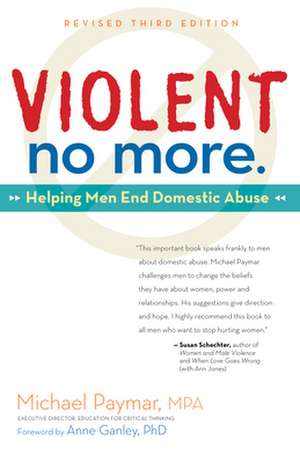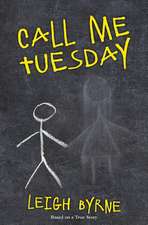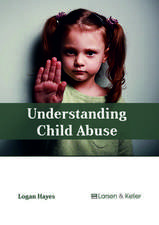Violent No More: Helping Men End Domestic Abuse
Autor Michael Paymar Anne Ganleyen Limba Engleză Paperback – 29 dec 2014
Violent No More is for men who have struggled with or are currently being violent in an intimate relationship. Filled with real stories of men who have harmed the ones they love and found the courage to change, this highly acclaimed book has helped thousands acknowledge and reform their abusive behavior. Author Michael Paymar doesn't sidestep the unpleasant reality of domestic violence—included here are the sometimes shocking first-person accounts of violent men, along with those of battered women. More importantly, many of these stories illustrate the ways in which men were able to stop their use of violence and control. This edition contains four new chapters which address the challenges faced by practitioners who work with domestic violence offenders or victims, and the particular struggles faced by combat veterans returning from war, many of whom come home with PTSD and other mental health issues. With group exercises and individual goal-setting plans to help men find healthy ways of responding to conflict, change the cultural conditioning that condones violence, and avoid reverting to old patterns, Violent No More is an essential guide for men dealing with violence issues, as well as for the professionals who assist in their efforts to improve.
| Toate formatele și edițiile | Preț | Express |
|---|---|---|
| Paperback (1) | 154.41 lei 3-5 săpt. | |
| Hunter House Publishers – 29 dec 2014 | 154.41 lei 3-5 săpt. | |
| Hardback (1) | 211.38 lei 3-5 săpt. | |
| Hunter House Publishers – 23 feb 2015 | 211.38 lei 3-5 săpt. |
Preț: 154.41 lei
Nou
Puncte Express: 232
Preț estimativ în valută:
29.55€ • 30.94$ • 24.51£
29.55€ • 30.94$ • 24.51£
Carte disponibilă
Livrare economică 19 martie-02 aprilie
Preluare comenzi: 021 569.72.76
Specificații
ISBN-13: 9780897936651
ISBN-10: 0897936655
Pagini: 336
Dimensiuni: 137 x 216 x 20 mm
Greutate: 0.48 kg
Ediția:Third Edition
Editura: Hunter House Publishers
ISBN-10: 0897936655
Pagini: 336
Dimensiuni: 137 x 216 x 20 mm
Greutate: 0.48 kg
Ediția:Third Edition
Editura: Hunter House Publishers
Cuprins
Foreword
Preface
Acknowledgments
Introduction
Why Write a Book for Men Who Batter?
A Note to the Reader
Chapter 1: A Challenge for Men
Andy’s Story
Andy’s Story Five Years Later
The First Step: Owning the Problem
The Next Step: Getting Help
How to Use This Book
Chapter 2: The Roots of Men’s Violence against Women
The Superman Myth
How Our Culture Encourages Violence
The Struggle for Equality
What Men Expect from Relationships
Chapter 3: The Origins of Abuse and Sexual Violence
Cassie’s Story
Bernice’s Story
Women and Violence
The Violence We Learn at Home
The Violence We Learn from Society
Why We Use Violence
Sexual Violence
The Impact of Violence on Sexual Relationships
Chapter 4: It’s More Than Just Physical Violence
Jim’s Story
Using Intimidation to Control
Using Threats
Blocking Her Freedom to Decide
Using the Children to Get to Her
The Pain of Emotional Abuse
Understanding and Stopping Battering
Chapter 5: Getting Past Denial
Sid’s Story
Taking Responsibility
Minimizing Violence
Self-Defense or Retaliation?
Guidelines for Remaining Nonviolent
Letting Go of Blame
Alcohol, Drugs, and Violence
Anger
Chapter 6: Making Changes and Staying on Track
Mark’s Story
Letting Go
Taking Time-Outs
Time-Out Rules
Self-Talk: Learning to Think Positively
Handling Jealousy
The Danger of Obsession
Chapter 7: Staying Together
What Traps a Woman in an Abusive Relationship?
The Switzers’ Story
It May Always Be a Struggle
Understanding and Accepting Women’s Anger
Changing the Mind-Set
Getting Your Needs Met without Being Abusive
Chapter 8: Resolving Conflicts, Strengthening Relationships
Elliot’s Story
New Relationships, Old Problems
Egalitarian Relationships
Sharing the Load
The Issue of Money
Expressing Feelings
Learning to Negotiate and Compromise
Negotiation Guide
Fair Discussion Guide
Developing a Personal Responsibility Program
Chapter 9: Healing
Dave’s Story
Dave’s Story Five Years Later
Support for Changing Men
New Definitions of Masculinity
Health and Balance 1
Dating: How Much of the Past Do We Reveal?
Talking to Your Children about Your Violence
Staying on Course: Your Lifelong Commitment
Chapter 10: Veterans Coming Home
Hector’s Story
Screening for Mental Health Problems
Veteran’s Courts
Changing Military Culture
Chapter 11: Creating Change in Groups
Ron’s Story
Expectations of Counseling
The Theory and Practice of Offender Programs
The Duluth Curriculum: New Approaches
How Well Does Counseling Work?
The Principles of an Offender Program
Intake, Orientation and Screening
Partner Orientation and Safety Procedures
Controversies in the Field
Research: What Do We Know?
Women that Use Violence in Relationships
Chapter 12: Danger and Lethality
Dale’s Story from Prison
Assessment Tools
Chapter 13: Primary Prevention: The New Frontier
Stopping Rape on College Campuses
Reducing Demand for Violent Pornography
Trafficking: Choices for Men
Backlash: The War on Women
Social Change
Preface
Acknowledgments
Introduction
Why Write a Book for Men Who Batter?
A Note to the Reader
Chapter 1: A Challenge for Men
Andy’s Story
Andy’s Story Five Years Later
The First Step: Owning the Problem
The Next Step: Getting Help
How to Use This Book
Chapter 2: The Roots of Men’s Violence against Women
The Superman Myth
How Our Culture Encourages Violence
The Struggle for Equality
What Men Expect from Relationships
Chapter 3: The Origins of Abuse and Sexual Violence
Cassie’s Story
Bernice’s Story
Women and Violence
The Violence We Learn at Home
The Violence We Learn from Society
Why We Use Violence
Sexual Violence
The Impact of Violence on Sexual Relationships
Chapter 4: It’s More Than Just Physical Violence
Jim’s Story
Using Intimidation to Control
Using Threats
Blocking Her Freedom to Decide
Using the Children to Get to Her
The Pain of Emotional Abuse
Understanding and Stopping Battering
Chapter 5: Getting Past Denial
Sid’s Story
Taking Responsibility
Minimizing Violence
Self-Defense or Retaliation?
Guidelines for Remaining Nonviolent
Letting Go of Blame
Alcohol, Drugs, and Violence
Anger
Chapter 6: Making Changes and Staying on Track
Mark’s Story
Letting Go
Taking Time-Outs
Time-Out Rules
Self-Talk: Learning to Think Positively
Handling Jealousy
The Danger of Obsession
Chapter 7: Staying Together
What Traps a Woman in an Abusive Relationship?
The Switzers’ Story
It May Always Be a Struggle
Understanding and Accepting Women’s Anger
Changing the Mind-Set
Getting Your Needs Met without Being Abusive
Chapter 8: Resolving Conflicts, Strengthening Relationships
Elliot’s Story
New Relationships, Old Problems
Egalitarian Relationships
Sharing the Load
The Issue of Money
Expressing Feelings
Learning to Negotiate and Compromise
Negotiation Guide
Fair Discussion Guide
Developing a Personal Responsibility Program
Chapter 9: Healing
Dave’s Story
Dave’s Story Five Years Later
Support for Changing Men
New Definitions of Masculinity
Health and Balance 1
Dating: How Much of the Past Do We Reveal?
Talking to Your Children about Your Violence
Staying on Course: Your Lifelong Commitment
Chapter 10: Veterans Coming Home
Hector’s Story
Screening for Mental Health Problems
Veteran’s Courts
Changing Military Culture
Chapter 11: Creating Change in Groups
Ron’s Story
Expectations of Counseling
The Theory and Practice of Offender Programs
The Duluth Curriculum: New Approaches
How Well Does Counseling Work?
The Principles of an Offender Program
Intake, Orientation and Screening
Partner Orientation and Safety Procedures
Controversies in the Field
Research: What Do We Know?
Women that Use Violence in Relationships
Chapter 12: Danger and Lethality
Dale’s Story from Prison
Assessment Tools
Chapter 13: Primary Prevention: The New Frontier
Stopping Rape on College Campuses
Reducing Demand for Violent Pornography
Trafficking: Choices for Men
Backlash: The War on Women
Social Change
Recenzii
"Finally, someone has written a book for men in offender groups, rather than for those of us who facilitate them. Paymar's book is written to men, using the voices of men. It poses the most central question to men who batter—how did I get here and what does it take for me to change?" — Ellen Pence, Ph.D., founder of Duluth Domestic Abuse Intervention Project
"A highlight of the book is the many inspiring stories by individual men of their violence and their process of change. This book should convince any man that we can and must stop violence against women." — Paul Kivel, author of Men’s Work: How to Stop the Violence that Tears Our Lives Apart
"A highlight of the book is the many inspiring stories by individual men of their violence and their process of change. This book should convince any man that we can and must stop violence against women." — Paul Kivel, author of Men’s Work: How to Stop the Violence that Tears Our Lives Apart
Notă biografică
Michael Paymar has lectured and trained, both nationally and internationally, on human rights and ending gender-based violence. He provides training and technical assistance to professionals in the criminal and civil justice system, law enforcement, and the military on how to end domestic violence. Paymar lives in Minneapolis, MN, where he serves in the U.S. House of Representatives. Anne Ganley lives in Seattle, WA.
Extras
From the Introduction:
Somehow and somewhere men learn destructive attitudes and behaviors. The relationships of men who abuse their partners are like minefields: nobody knows when things might explode and all hell breaks loose. Living in this minefield causes terror and hurts the entire family. Inside, the man knows it doesn’t have to be like this. All of us have the inherent ability to experience fulfilling relationships that provide meaning and love in our lives.
From Chapter 1:
Men who are violent or abusive often project an attitude of not needing or not wanting to change. Deep down, most of them know that something is not right. They start new relationships with high expectations only to see their abusive behavior tear the relationships apart. They medicate themselves with drugs, alcohol, and cynicism about life and relationships. Their friendships with other men are frequently superficial. They see their children acting out in inappropriate ways because of what is happening at home, and they don’t know what to do. They see their partners, who once loved them, turn away in anger and in fear. All too often they end up alone, out of touch with their own feelings and cut off from the company and affection of others, pretty much trapped.
Men are not naturally violent, but they learn that violence is an appropriate male response to settling disagreements. Men also learn that violence can bring a feeling of power. However, men can reject the cultural conditioning that spawns this violence. They can reject sexist beliefs that women are less significant than men. We can teach our sons and daughters that men and women are equal, that relationships should be respectful, and that violence is not an acceptable way to resolve conflicts.
From Chapter 2:
Men are socialized to view so-called “feminine” characteristics—sensitivity and the expression of feelings—with hostility. These qualities are perceived as opposite to what is required to be a real man, or a superman. At an early age, boys begin to reject their gentler feelings or any characteristics that may make them seem vulnerable. Failure to live up to the male persona may bring scorn and ridicule by their peers, so boys learn quickly to adapt. By the time they are adults, men have learned to deny sensitive feelings or have lost touch with them altogether. This “real” man now enters into a relationship with a woman, often bringing with him suppressed feelings and unrealistic expectations of how men are supposed to behave. What a recipe for problems and conflict!
From Chapter 9:
Today, many men are working to confront violence in their own communities. With the rash of school killings committed by boys, and rampant inner-city gang violence usually perpetrated by males, men are recognizing the importance of working to sensitize society and especially boys and men on the impact of violence.
From the Conclusion:
A man who batters tries to justify his behavior, yet the terror in his partner’s eyes is always there as a reminder that he—and no one else—has done something hurtful and abusive. Men who batter say, “I don’t understand,” but they do. There is no excuse. In their attempt to avoid responsibility they dig in their heels and try not to feel or remember. They turn on a kind of psychic numbing to have peace within themselves. A friend once told me that a man who batters looks in the mirror, sees that his face is dirty, and wipes the mirror to get it clean. Yet, some men do face the problem head-on and make commitments to change. You have met some of these men in this book.
Somehow and somewhere men learn destructive attitudes and behaviors. The relationships of men who abuse their partners are like minefields: nobody knows when things might explode and all hell breaks loose. Living in this minefield causes terror and hurts the entire family. Inside, the man knows it doesn’t have to be like this. All of us have the inherent ability to experience fulfilling relationships that provide meaning and love in our lives.
From Chapter 1:
Men who are violent or abusive often project an attitude of not needing or not wanting to change. Deep down, most of them know that something is not right. They start new relationships with high expectations only to see their abusive behavior tear the relationships apart. They medicate themselves with drugs, alcohol, and cynicism about life and relationships. Their friendships with other men are frequently superficial. They see their children acting out in inappropriate ways because of what is happening at home, and they don’t know what to do. They see their partners, who once loved them, turn away in anger and in fear. All too often they end up alone, out of touch with their own feelings and cut off from the company and affection of others, pretty much trapped.
Men are not naturally violent, but they learn that violence is an appropriate male response to settling disagreements. Men also learn that violence can bring a feeling of power. However, men can reject the cultural conditioning that spawns this violence. They can reject sexist beliefs that women are less significant than men. We can teach our sons and daughters that men and women are equal, that relationships should be respectful, and that violence is not an acceptable way to resolve conflicts.
From Chapter 2:
Men are socialized to view so-called “feminine” characteristics—sensitivity and the expression of feelings—with hostility. These qualities are perceived as opposite to what is required to be a real man, or a superman. At an early age, boys begin to reject their gentler feelings or any characteristics that may make them seem vulnerable. Failure to live up to the male persona may bring scorn and ridicule by their peers, so boys learn quickly to adapt. By the time they are adults, men have learned to deny sensitive feelings or have lost touch with them altogether. This “real” man now enters into a relationship with a woman, often bringing with him suppressed feelings and unrealistic expectations of how men are supposed to behave. What a recipe for problems and conflict!
From Chapter 9:
Today, many men are working to confront violence in their own communities. With the rash of school killings committed by boys, and rampant inner-city gang violence usually perpetrated by males, men are recognizing the importance of working to sensitize society and especially boys and men on the impact of violence.
From the Conclusion:
A man who batters tries to justify his behavior, yet the terror in his partner’s eyes is always there as a reminder that he—and no one else—has done something hurtful and abusive. Men who batter say, “I don’t understand,” but they do. There is no excuse. In their attempt to avoid responsibility they dig in their heels and try not to feel or remember. They turn on a kind of psychic numbing to have peace within themselves. A friend once told me that a man who batters looks in the mirror, sees that his face is dirty, and wipes the mirror to get it clean. Yet, some men do face the problem head-on and make commitments to change. You have met some of these men in this book.



























